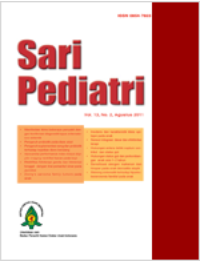Pengaruh Pemberian Gentamisin Intravena Terhadap Kadar Kidney Injury Molecule-1 Urin pada Neonatus Cukup Bulan Sesuai Masa Kehamilan
Sari
Latar belakang. Gentamisin telah digunakan secara luas sebagai lini pertama infeksi neonatus. Gentamisin akan terakumulasi di dalam jaringan tubuh terutama ginjal Sehingga dapat menganggu fungsi ginjal. Kidney injury molecule-1 (KIM-1) urin merupakan biomarker baru yang digunakan untuk menilai fungsi ginjal.
Tujuan. Mengetahui pengaruh gentamisin intravena terhadap kadar KIM-1 urin dan kreatinin serum.
Metode. Penelitian dengan pendekatan pra-pasca uji. Penelitian ini dilakukan di Neonatal Intensive Care Unit (NICU) mulai Desember 2016 sampai Maret 2017. Pada neonatus cukup bulan sesuai masa kehamilan yang diterapi dengan gentamisin intravena 5 mg/KgBB/36 jam selama 5 hari. Kelainan kongenital, asfiksia, dan kondisi kritis diekslusi. Kadar KIM-1 urin diukur menggunakan teknik ELISA dengan modifikasi “sandwich assayâ€. Pengambilan sampel dengan metode consecutive sampling. Digunakan analisis deskriptif dan uji t berpasangan (p<0,05).
Hasil. Empat puluh neonatus terdiri dari 28 bayi laki-laki dan 12 bayi perempuan. Terjadi peningkatan rerata kadar KIM-1 urin sebelum mendapat gentamisin sebesar 2,80 ng/ml menjadi 3,04 ng/ml setelah pemberian gentamisin (p=0,031). Terjadi penurunan rerata kadar kreatinin serum sebelum mendapat gentamisin sebesar 0,73 mg/dl menjadi 0,43 mg/dl setelah pemberian gentamisin (p<0,0001).
Kesimpulan. Pemberian gentamisin pada neonatus cukup bulan sesuai masa kehamilan selama 5 hari didapatkan peningkatan kadar KIM-1 urin.
Â
Kata Kunci
Teks Lengkap:
PDFReferensi
Pacifici GM. Clinical pharmacokinetics of aminoglycosides in the neonate: a review. Eur J Clin Pharmacol 2009;65:419–27.
Aminullah A. Sepsis pada bayi baru lahir. Dalam: Kosim MS, Yunanto A, Dewi R, Sarosa GI, Usman A, penyunting. Buku ajar neonatologi. Jakarta: IDAI; 2012.h.170-87.
Obiero CW, Seale AC, Berkley JA. Empiric treatment of neonatal sepsis in developing countries. Pediatr Infect Dis J 2015 ;34:659-61.
Rao SC, Ahmed M, Hagan R. One dose per day compared to multiple doses per day of gentamicin for treatment of suspected or proven sepsis in neonates (review). Cochrane Database Syst Rev 2006.
Ward RM, Lugo RA. Drug therapy in the newborn. Dalam: MacDonald MG, Seshia MMK, Mullet MD, penyunting. Avery’s Neonatology: Pathophysiology & Management of the Newborn. Edisi keenam. Philadelphia: Lippincott Williams & Wilkins;2005.h.1527-9.
McWilliam SJ, Antoine DJ, Sabbisetti V, dkk. Mechanismbased
urinary biomarkers to identify the potential for aminoglycoside-induced nephrotoxicity in premature neonates: a proof-of-concept study. PLoS One 2012;7:e43809.
Devarajan P. Biomarkers for the early detection of acute kidney injury. Curr Opin Pediatr 2011;23:194-200.
Huang Y, Craig A. The clinical utility of kidney injury molecule 1 in the prediction, diagnosis and prognosis of acute kidney injury: a systematic review. Inflammation & allergy – Drug Targets 2011;10:260-71.
Waikar SS, Bonventre J. Creatinine kinetics and the definition of acute kidney injury. J. Am. Soc. Nephrol 2009;20:672-9.
Vaidya VS, Waikar SS, Ferguson MA, dkk. Urinary biomarkers for sensitive and specific detection of acute kidney injury in humans. Clin. Transl. Sci 2008;1:200-8.
Han WK, Bailly V, Abichandani R, Thadhani R, Bonventre JV. Kidney injury molecule-1 (KIM-1): a novel biomarker for human renal proximal tubule injury. Kidney Int 2002;62:237-44.
Fuchs A, Guidi M, Giannoni E, dkk. Population pharmacokinetic study of gentamicin in a large cohort of premature and term neonates. Br J Clin Pharmacol 2014;78:1090-101.
Sarafidis K, Tsepkentzi E, Agakidou, dkk. Serum and urine biomarkers in asphyxiated neonates. Pediatr Nephrol 2012;27:1575.
Askenazi DJ, Koralkar R, Levitan EB, dkk. Baseline Values of Candidate Urine Acute Kidney Injury (AKI) Biomarkers Vary by Gestational Age in Premature Infants. Pediatric Res 2011;70:302-06.
Saeidi B, Koralkar R, Griffin RL, Halloran B, Ambalavanan N, Askenazi DJ. Impact of gestational age, sex, and postnatal age on urine biomarkers in premature neonates. Pediatr Nephrol 2015 Nov;30:2037-44.
Jansen D, Peters E, Heemskerk S, dkk. Tubular Injury Biomarkers to Detect Gentamicin-Induced Acute Kidney Injury in the Neonatal Intensive Care Unit. Am J Perinatol 2016;33:180-7.
Kamianowska M, Szczepanski M, Kulikowska E, Bebko B. Do Serum and Urinary Concentrations of Kidney Injury Molecule-1 in Healthy Newborns Depend on Birth Weight, Gestational Age or Gender? J Perinatol 2016;37:73-6.
Zwiers AJ, de Wildt SN, de Rijke YB, dkk. Reference intervals for renal injury biomarkers neutrophil gelatinase-associated lipocalin and kidney injury molecule-1 in young infants. Clin Chem Lab Med 2015;53:1279-89.
Pennemans V, Rigo JM, Faes C, Reynders C, Penders J, Swennen Q. Establishment of reference values for novel urinary biomarkers for renal damage in the healthy population: are age and gender an issue? Clin Chem Lab Med 2013;51:1795-802.
Genc G, Ozkaya O, Avci B. Kidney Injury Molecule-1 as a Promising Biomarker for Acute Kidney Injury in Premature Babies. Am J Perinatol 2012;30:245-52
Boer DP, de Rijke YB, Hop WC, Cransberg K, Dorresteijn EM. Reference values for serum creatinine in children younger than 1 year of age. Pediatr Nephrol 2010;25:2107-13.
Jetton JG, Askenazi DJ. Acute kidney injury in the neonate. Clin Perinatol 2014;41:487-502.
Kastl JT. Renal function in the fetus and neonate - the creatinine enigma. Semin Fetal Neonatal Med 2017;22:83-9.
Abitbol CL, Seeherunvong W, Galarza MG, dkk. Neonatal kidney size and function in preterm infants: what is a true estimate of glomerular filtration rate? J Pediatr 2014;164:1026-31.e2
DOI: http://dx.doi.org/10.14238/sp19.6.2018.342-8
Refbacks
- Saat ini tidak ada refbacks.
##submission.copyrightStatement##
##submission.license.cc.by-nc-sa4.footer##
Email: editorial [at] saripediatri.org


Sari Pediatri diterbitkan oleh Badan Penerbit Ikatan Dokter Anak Indonesia
Ciptaan disebarluaskan di bawah Lisensi Creative Commons Atribusi-NonKomersial-BerbagiSerupa 4.0 Internasional.




